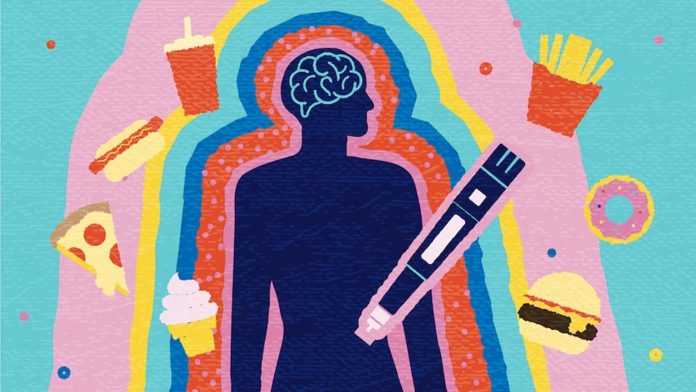When Jenni* started using a medication called liraglutide to lose weight, she noticed changes not just in her appetite, but in how she thought about food.
Where the smell of hot chips in the deep fryer would previously elicit a deep craving for the crunchy, salty snack, she suddenly had zero interest in them.
You May Like
And her food cravings evaporated.
“All of that was just blanked out, completely cancelled, which was so great,” Jenni says.
Liraglutide is part of a class of drugs known as GLP-1 receptor agonists. Medicines in this class include tirzepatide (brand name Mounjaro) and semaglutide (sold as Ozempic and Wegovy).
In Australia, Mounjaro, Wegovy and Saxenda (liraglutide) are approved for weight loss.
People on these medications commonly report they no longer have constant, incessant thoughts about food — sometimes called “food noise” — and that their cravings for sweets and fried treats disappear.
And it’s not just a hankering for hot chips or chocolate that appears to be reduced by these drugs. Cravings for alcohol, other drugs, and even gambling might also be dialled down, according to some studies.

So how do these kinds of drugs have such profound effects on the brain?
What are GLP-1 receptor agonists?
GLP-1 agonists (also called GLP-1 receptor agonists or GLP-1 analogues) are usually injectable medications that help manage blood sugar levels in people with type 2 diabetes.
They do this by mimicking a hormone called glucagon-like peptide 1, or GLP-1. GLP-1 binds to receptors in the pancreas and stimulates insulin secretion. Insulin helps shuttle sugar out of the blood and into the body’s cells.
In the early 1900s, scientists thought giving GLP-1 directly to people with diabetes might help control their blood sugar levels.
Unfortunately, GLP-1 breaks down in the human body in a matter of minutes, so isn’t useful for long-term blood glucose management, Lotus Jeffs, who studies anti-obesity medications and the brain at Monash University, says.
A turning point came in the 1980s, when a molecule similar to GLP-1 was discovered in the saliva of the venomous Gila monster (Heloderma suspectum).

Scientists realised the molecule latched onto the same receptors as GLP-1 but didn’t break down as quickly. It could decrease blood sugar levels in mice and people with type 2 diabetes for hours.
It was made into a drug called exenatide and in 2005, approved by the US Food and Drug Administration.
During the 1990s, drug companies were also working on their own GLP-1 agonists. Novo Nordisk, for instance, developed the drug liraglutide, which was a daily injection, and long-acting GLP-1 agonists such as semaglutide, a weekly injection.
How do Ozempic and other GLP-1 agonists work in the brain?
As well as increasing insulin from the pancreas, GLP-1 agonists slow the movement of food through the gut.
“There’s stretch receptors in your stomach that tell your brain how full you are, how much of a meal you’ve had,” Ms Jeffs says.
“The longer that food sits in the stomach, the longer these signals are being sent to the brain, and so you feel full for longer.”
This slower food movement could explain some of the common gastrointestinal side effects associated with these drugs.
These “fullness” signals are sent up the vagus nerve, which carries information between the brain and internal organs.
But GLP-1 agonists can also act directly on brain cells. They can squeeze out of blood vessels and into a part of the brain called the hindbrain, which sits just on top of the spinal cord.
The hindbrain is partly responsible for us feeling full — as well as feelings of nausea, which may explain another common side effect.
Multiple studies show GLP-1 agonist drugs can also eliminate a person’s penchant for sweets or fried food, perhaps also due to the actions of the hindbrain, and the brain regions it connects to.
But these connections are complex, and scientists are still unravelling the brain circuits involved in GLP-1 agonist weight loss, Ms Jeffs says.
“A lot of areas in the brain interact with each other to cause this one overall effect.”
Can GLP-1 agonists help curb alcohol cravings?
In recent years, research in animals suggests GLP-1 agonists can also help curb cravings for alcohol and other addictive substances.
The drugs have shown promise in some human studies too.
For instance, a small study of people in the US, published in the journal JAMA Psychiatry last month, gave a low dose of semaglutide to people with alcohol use disorder each week for nine weeks.
The researchers found participants on GLP-1 agonists craved alcohol less than those on the placebo, and reduced the number of drinks they consumed on the days they drank alcohol.
Those who smoked cigarettes also reported smoking less.
That said, not all GLP-1 agonist studies show a clear reduction in alcohol cravings.
A Danish study from 2022, which administered exenatide — the drug developed from the Gila monster — found no broad differences in cravings or drinking reduction between those on the drug and those on a placebo.
What they did find, however, was people with obesity and alcohol use disorder reduced their drinking, on average, over the course of the 26-week study.
“So it looks like there is potential for these drugs to be used for … alcohol use disorder,” Ms Jeffs says.
“However, our understanding into what’s driving that [potential alcohol consumption and craving reduction] is still quite limited.”
*Surname withheld for privacy.
Do you think these drugs could be a game-changer for individuals struggling with cravings beyond food? Have you or someone you know tried GLP-1 agonists? Feel free to share your experiences or opinions in the comments below!

